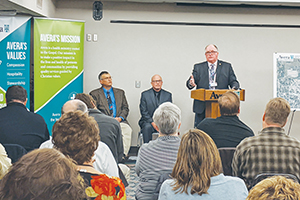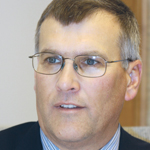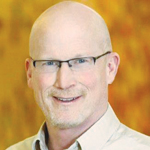By DALE SINGER
The situation was this:
Mitchell, South Dakota, had a problem supplying affordable housing for the middle-income workers its employers need.
Avera Queen of Peace Hospital, an anchor of the city's economy, owned an undeveloped tract of 21.7 acres just east of its main campus — land that it no longer needed because future growth would be in a more visible spot along nearby Interstate 90.

Tom Clark, regional president of Avera Health and chief executive of Avera Queen of Peace Hospital, shares plans for a land donation the health organization will make to the City of Mitchell for an affordable housing project. He spoke at a press conference and stakeholder announcement held Jan. 9 at the Mitchell, South Dakota, hospital. Seated behind him are Mayor Bob Everson, left, and Mitchell Area Development Corp. Executive Director Mark Vaux.
Nathan Johnson/Avera Health
As a member of the Mitchell Area Development Corp., Tom Clark, regional president of Avera Health and the hospital's chief executive, was aware of the housing challenge but he hadn't really connected it to the surplus land before.
Then, the proverbial light bulb lit up.
"It just popped," Clark said. "It just kind of clicked. We've got this land that we're not going to use, and there's a need for affordable housing. I wonder if there's a way for the two to come together.
"It was just fortuitous timing. I truly believe it was a God thing," he said.
It all adds up
With a three-pronged partnership of the hospital, the city and the development corporation, the project came together quickly. The vision has Avera donating land that will become the site of 94 single-family homes, to be built in two phases. Once the necessary government approvals win passage and the spring thaw arrives, work is set to begin. The first phase calls for eight homes to be completed by the end of this year and 55 to be built by the end of 2024. Target price for the homes is less than $200,000.
The development is designed to solve cost hurdles that often can stymie efforts to build the kind of housing that communities like Mitchell need.

Clark
"It works because of the land donation, keeping land costs out of the total development costs," Clark said. "It works because of the city and its willingness to use tax increment financing to fund infrastructure installation. And it works because of the development group bringing developers to the table.
"We're really excited. This is a huge project for this community. And it happens because of the partnership."
Workforce recruitment tool
That team will help solve a stubborn problem that the region and the state in general have faced for a while, according to Clark, Mitchell Mayor Bob Everson and Mark Vaux, executive director of the area's development corporation. In a number of fields, ranging from teachers to police officers, health care workers to IT professionals, jobs that pay in the $50,000-$70,000 range too often can go unfilled because potential employees can't find the kind of housing that they need.

Everson
The three principals in the Avera plan noted that Gov. Kristi Noem highlighted the situation in her recent State of the State address.
"Workforce is a huge issue in the state of South Dakota," Clark said. "We have more jobs than we have workers. The problem for normal development is that by the time a developer pays land costs and infrastructure costs, there is no way they can build a home in the price range that middle-income workers can afford.
"The beauty of this project is that the land costs are taken out of the equation, and the infrastructure costs are taken out of the equation."

Vaux
Everson said the project fits perfectly with the goals of Forward 2040, Mitchell's development plan.
"This is one of the top items that came out of that," he said. "We don't have enough affordable housing. It's tough for entry-level workers to get into housing, without paying rent for a prolonged period of time. This will build a tax base for our city and our county."
The trio spearheading the plan were clearly excited about how Avera and Mitchell were able to come up with a forward-looking project that could even inspire similar development elsewhere.
"This is a brand-new model that has never been done before, to our knowledge, anywhere in the state of South Dakota, and I haven't found it anywhere else," Vaux said. "There have been other communities and economic development organizations that have worked on housing. But the difference that made this go is the tremendous gift from Avera. That is the element that completes this opportunity.
"This is a model that can be replicated to scale in any other community. So, we're excited about that opportunity. Others are starting to take notice and see the potential. We're building a small town. That's pretty cool."
Addressing heritage, mission
Plans call for the development to be known as Ridge View on Foster, after the street that is near the land that currently is prairie or pasture. Street names submitted for approval would reflect Avera's donation and its heritage, including:
Also present in the project, Clark said, will be Avera's commitment to the mission that guides the hospital every day.
"It allows us to be a good steward of the resources God has blessed us with," he said. "It allows us to work in partnership with others to achieve something that none of us would be able to do on our own. And, it allows us to live our value of hospitality by creating homes and opportunities for the families that will inhabit them.
"This really is the mission of our organization. That is one of the things that makes this so exciting."